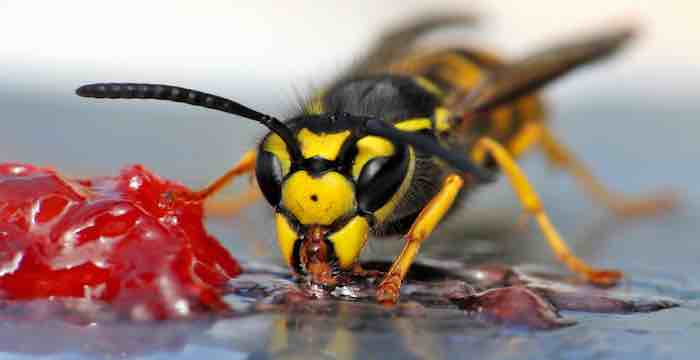
Wasps get a good and a bad rap. Initially they prey upon other arthropods. Many of these, bugs, caterpillars, flies and others, are considered garden pests. These they chew up to feed their larvae back at their nest.
Unfortunately, when wasp colonies stop breeding new workers in late summer, the existing workers search for the sweeter things in life. These are often supplied by humans, especially in the shape of soft drinks and fruit.
So, people often stung in late summer. Wearing perfumes, colognes and scented hair sprays will also attract
Vespula species. Most of the time, this is simply painful. Some people, however, can go into anaphylactic, possibly fatal shock.
Multiple stings resulting from a too-close encounter with a nest can also cause anaphylactic shock. Worse, unlike bees, enraged wasps can sting more than once with lance-like stingers.
North Americans know them as 'yellowjackets.' The rest of the English-speaking world simply calls them 'wasps.' Although several are native to North America such as the eastern, western and prairie yellowjackets, the common wasp,
Vespula vulgaris, is believed to have arrived here from Europe in the 1920s. More aggressive, the German yellowjacket,
Vespula germanica, was first detected 1975 in Ohio.
Regardless of species, only the already inseminated queen survives overwinter, sheltered in a natural or human supplied structure. Some early spring, she commences breeding, perhaps in a mousehole, often in a house wall or roof, perhaps a garage. The resulting workers build a nest of chewed wood fibre. This may attain football size, sheltering a colony of 4,000 to 5,000.
Imitation nests are sold to hang in trees or other locations. Since wasps are territorial, these are said to discourage wasp invasions. There are also traps. In the simplest form, these consist of a funnel atop a clear container of syrupy water or soda pop. The wasps crawl in, cannot escape and drown.
Insecticides in canisters with powerful jet sprays are available for destroying entire colonies. Use only after nightfall when all the workers have returned. In doing this, do not point a flashlight directly at the nest entrance. The wasps will be alerted, fly down the beam, and--ouch!
 Wasps get a good and a bad rap. Initially they prey upon other arthropods. Many of these, bugs, caterpillars, flies and others, are considered garden pests. These they chew up to feed their larvae back at their nest.
Unfortunately, when wasp colonies stop breeding new workers in late summer, the existing workers search for the sweeter things in life. These are often supplied by humans, especially in the shape of soft drinks and fruit.
Wasps get a good and a bad rap. Initially they prey upon other arthropods. Many of these, bugs, caterpillars, flies and others, are considered garden pests. These they chew up to feed their larvae back at their nest.
Unfortunately, when wasp colonies stop breeding new workers in late summer, the existing workers search for the sweeter things in life. These are often supplied by humans, especially in the shape of soft drinks and fruit.